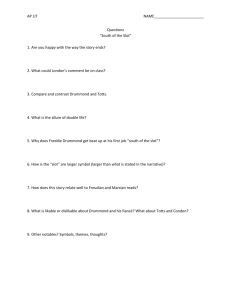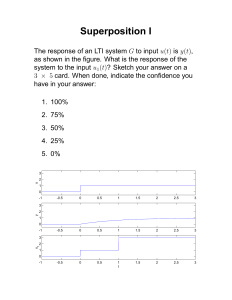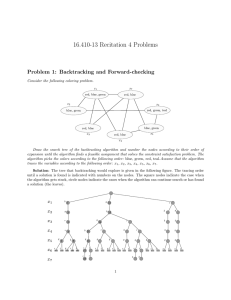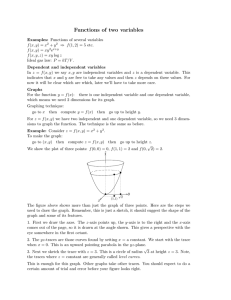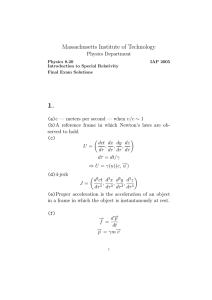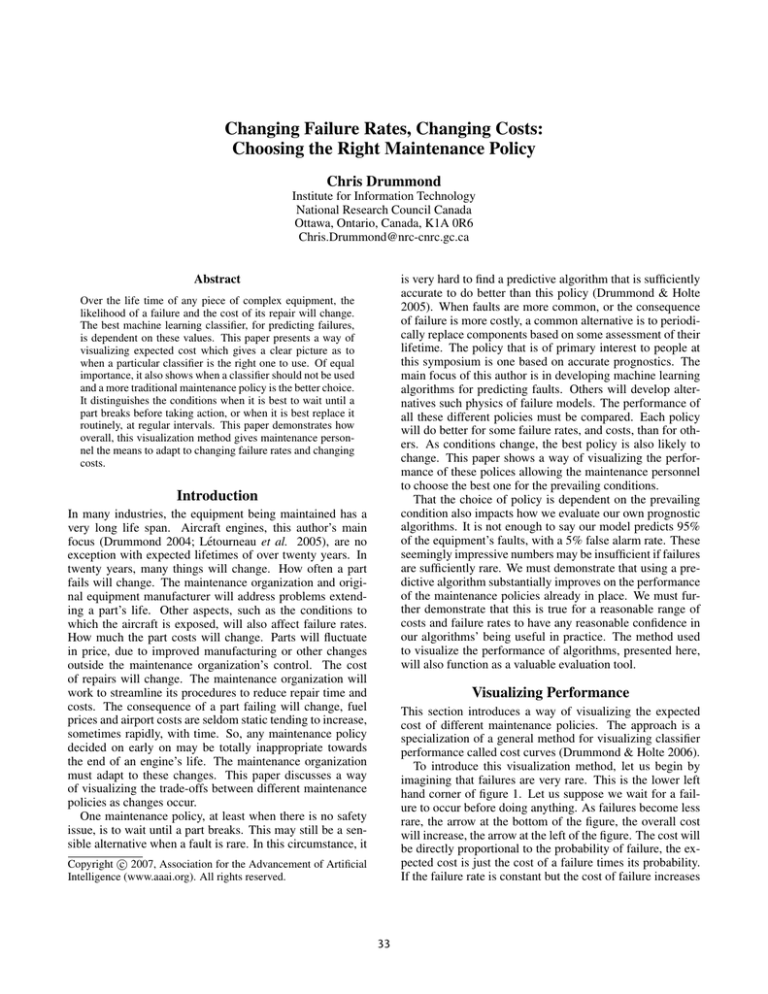
Changing Failure Rates, Changing Costs:
Choosing the Right Maintenance Policy
Chris Drummond
Institute for Information Technology
National Research Council Canada
Ottawa, Ontario, Canada, K1A 0R6
Chris.Drummond@nrc-cnrc.gc.ca
is very hard to find a predictive algorithm that is sufficiently
accurate to do better than this policy (Drummond & Holte
2005). When faults are more common, or the consequence
of failure is more costly, a common alternative is to periodically replace components based on some assessment of their
lifetime. The policy that is of primary interest to people at
this symposium is one based on accurate prognostics. The
main focus of this author is in developing machine learning
algorithms for predicting faults. Others will develop alternatives such physics of failure models. The performance of
all these different policies must be compared. Each policy
will do better for some failure rates, and costs, than for others. As conditions change, the best policy is also likely to
change. This paper shows a way of visualizing the performance of these polices allowing the maintenance personnel
to choose the best one for the prevailing conditions.
That the choice of policy is dependent on the prevailing
condition also impacts how we evaluate our own prognostic
algorithms. It is not enough to say our model predicts 95%
of the equipment’s faults, with a 5% false alarm rate. These
seemingly impressive numbers may be insufficient if failures
are sufficiently rare. We must demonstrate that using a predictive algorithm substantially improves on the performance
of the maintenance policies already in place. We must further demonstrate that this is true for a reasonable range of
costs and failure rates to have any reasonable confidence in
our algorithms’ being useful in practice. The method used
to visualize the performance of algorithms, presented here,
will also function as a valuable evaluation tool.
Abstract
Over the life time of any piece of complex equipment, the
likelihood of a failure and the cost of its repair will change.
The best machine learning classifier, for predicting failures,
is dependent on these values. This paper presents a way of
visualizing expected cost which gives a clear picture as to
when a particular classifier is the right one to use. Of equal
importance, it also shows when a classifier should not be used
and a more traditional maintenance policy is the better choice.
It distinguishes the conditions when it is best to wait until a
part breaks before taking action, or when it is best replace it
routinely, at regular intervals. This paper demonstrates how
overall, this visualization method gives maintenance personnel the means to adapt to changing failure rates and changing
costs.
Introduction
In many industries, the equipment being maintained has a
very long life span. Aircraft engines, this author’s main
focus (Drummond 2004; Létourneau et al. 2005), are no
exception with expected lifetimes of over twenty years. In
twenty years, many things will change. How often a part
fails will change. The maintenance organization and original equipment manufacturer will address problems extending a part’s life. Other aspects, such as the conditions to
which the aircraft is exposed, will also affect failure rates.
How much the part costs will change. Parts will fluctuate
in price, due to improved manufacturing or other changes
outside the maintenance organization’s control. The cost
of repairs will change. The maintenance organization will
work to streamline its procedures to reduce repair time and
costs. The consequence of a part failing will change, fuel
prices and airport costs are seldom static tending to increase,
sometimes rapidly, with time. So, any maintenance policy
decided on early on may be totally inappropriate towards
the end of an engine’s life. The maintenance organization
must adapt to these changes. This paper discusses a way
of visualizing the trade-offs between different maintenance
policies as changes occur.
One maintenance policy, at least when there is no safety
issue, is to wait until a part breaks. This may still be a sensible alternative when a fault is rare. In this circumstance, it
Visualizing Performance
This section introduces a way of visualizing the expected
cost of different maintenance policies. The approach is a
specialization of a general method for visualizing classifier
performance called cost curves (Drummond & Holte 2006).
To introduce this visualization method, let us begin by
imagining that failures are very rare. This is the lower left
hand corner of figure 1. Let us suppose we wait for a failure to occur before doing anything. As failures become less
rare, the arrow at the bottom of the figure, the overall cost
will increase, the arrow at the left of the figure. The cost will
be directly proportional to the probability of failure, the expected cost is just the cost of a failure times its probability.
If the failure rate is constant but the cost of failure increases
c 2007, Association for the Advancement of Artificial
Copyright Intelligence (www.aaai.org). All rights reserved.
33
Alternative Maintenance Policies
we would have the same effect. So the probability of failure
and the cost of failure are closely related. If we normalize
the product of probability and cost so that it ranges from zero
to one we end up with the x-axis of figure 2. As we have normalized the x-axis, the y-axis, the expected cost also ranges
from 0 to 1. One is the maximum cost that could occur.
To investigate visualizing alternative maintenance policies
using this approach, let us imagine monitoring the exhaust
gas temperature of a gas turbine engine. As is common practice when using such engines, should the temperature exceed
a threshold the engine must be repaired. Sampling from a
lognormal distribution, commonly used to model “cyclesto-failure”, 1000 samples of different failure times are generated. Figure 3 shows three such distributions. Faults generated by the solid black curve occur very quickly after the
engine has been put in service. For the dashed black curve,
the time to failure and the variance are increased. Progressively longer and wider distributions model more infrequent
faults. The exhaust gas temperature is assumed to rise linearly but is overlaid with Gaussian noise. Many different
values for the lognormal distribution will model the different fault probabilities, from very common to very rare.
Replace on Failure
Probability of Failure
0.05
0.10
0.15
Greater
Cost
More Failures
Figure 1: Increasing Costs
0.5
Expected
Cost
0
0.00
If the failures become too common, or the cost of a failure becomes too high, rather that wait until a part fails we
would be better replacing it at every available opportunity.
Of course, in practice, maintaining the equipment in this circumstance is probably futile. It does however establish a
clear region, indicated by the cross-hatched triangle, where
useful maintenance policies must operate.
Probability−Cost
of Failure
100
200
days
300
400
Figure 3: Distribution of Faults
For the purposes of this paper, fault prediction will be
couched as a binary classification problem. The aim is to
predict the fault within a 20 day period, 5 days before the
fault. Let us first consider a routine maintenance policy that
recommends replacing the part 45 days after being put in
service. Thus it labels 20 days, and on, as positive examples. The performance of the policy is the gray solid curve
in figure 4. It has the best performance, the lowest expected
cost, in the center of the figure. This will occur when the
number of positives and the number of negative is the same,
i.e. the average time to failure is, indeed, 45 days. This policy could also be the best at other failure rates, when the cost
of failure varies with respect to the cost of repair. When the
cost of failure is much higher than the cost of repair, even
when the time to failure is longer it is still cost effecient to
replace the part at this time. Although routine maintenance
is an effective policy, should the failure rate change significantly, it quickly becomes of limited utility. Ultimately, it is
better to wait until the part breaks, or replace the part as the
opportunity arises, than to rely on this policy.
Of course, we could change the routine maintenance period. The two gray dashed-dotted lines in figure 5 are for
11111111111111111111111111
00000000000000000000000000
00000000000000000000000000
11111111111111111111111111
00000000000000000000000000
11111111111111111111111111
00000000000000000000000000
11111111111111111111111111
00000000000000000000000000
11111111111111111111111111
Replace on
Replace every
00000000000000000000000000
11111111111111111111111111
Failure
Opportunity
00000000000000000000000000
11111111111111111111111111
00000000000000000000000000
11111111111111111111111111
00000000000000000000000000
11111111111111111111111111
00000000000000000000000000
11111111111111111111111111
00000000000000000000000000
11111111111111111111111111
00000000000000000000000000
11111111111111111111111111
00000000000000000000000000
11111111111111111111111111
00000000000000000000000000
11111111111111111111111111
00000000000000000000000000
11111111111111111111111111
00000000000000000000000000
11111111111111111111111111
00000000000000000000000000
11111111111111111111111111
00000000000000000000000000
11111111111111111111111111
00000000000000000000000000
11111111111111111111111111
00000000000000000000000000
11111111111111111111111111
00000000000000000000000000
11111111111111111111111111
00000000000000000000000000
11111111111111111111111111
00000000000000000000000000
11111111111111111111111111
00000000000000000000000000
11111111111111111111111111
00000000000000000000000000
11111111111111111111111111
0
0
1
Figure 2: The Operating Region
34
0.5
0.0
0.1
Normalized Expected Cost
0.2
0.3
0.4
0.5
Normalized Expected Cost
0.2
0.3
0.4
portunity. In the more likely case, when failure is rare, this
prognostic algorithm outperforms any routine mainteance.
But it should be noted, that as the rarity increases its advantage over the replace on failure policy decreases until the
point that they are indistinguishable.
0.1
0.0 0.1 0.2 0.3 0.4 0.5 0.6 0.7 0.8 0.9 1.0
Probability_Cost(+)
0.0
Figure 4: Routine Maintenance
two policies with longer and shorter time periods. These
are optimum for different failure rates. What is noticeable,
however, that they offer less an improvement over say the
replace on failure policy.
0.0 0.1 0.2 0.3 0.4 0.5 0.6 0.7 0.8 0.9 1.0
Probability_Cost(+)
0.5
Figure 6: Using a Predictive Algorithm
Conclusions
0.1
Normalized Expected Cost
0.2
0.3
0.4
This paper has shown a way of visualizing the expected cost
of different maintenance policies. This will allow the maintenance personnel to make an informed choice when the frequency of failure or failure costs change. This sort of visualization is not only important in normal operation, it is also
critical for evaluating prognostic algorithms. Sometimes existing polices are the best and we need to determine when
our algorithms are going to be effective rather than spending
time where little advantage can be gained.
References
0.0
Drummond, C., and Holte, R. C. 2005. Severe class imbalance: Why better algorithms aren’t the answer. In Proceedings of the 16th European Conference on Machine Learning, 539–546.
Drummond, C., and Holte, R. C. 2006. Cost curves: An
improved method for visualizing classifier performance.
Machine Learning 65(1):95–130.
Drummond, C. 2004. Iterative semi-supervised learning:
Helping the user to find the right records. In Proceedings
of the Seventeenth International Conference on Industrial
and Engineering Applications of Artificial Intelligence and
Expert Systems, 1239–1248.
Létourneau, S.; Yang, C.; Drummond, C.; Scarlett, E.;
Valdés, J.; and Zaluski, M. 2005. A domain independent data mining methodology for prognostics. In Proc.
of Essential Technologies for Successful Prognostics, 59th
Meeting of the Machinery Failure Prevention Technology
Society.
0.0 0.1 0.2 0.3 0.4 0.5 0.6 0.7 0.8 0.9 1.0
Probability_Cost(+)
Figure 5: Other Maintenace Periods
Now let us look at the effect of a prognostic algorithm,
figure 6. A training set, drawn from the same lognormal distribution, was used to learn at what exhaust gas temperature
to recommend replacing the part. The algorithm simply calculated the average temperature 25 days before the problem,
across the instances in the training set. When applied to the
test data it labels everything as positive after this threshold
has been reached. It performs generally better than routine
maintenance, although notably its performance is not much
better when failures are common, the right hand side of the
figure. Indeed if failures are very common, the algorithm
is worse than simply replacing the component at every op-
35


